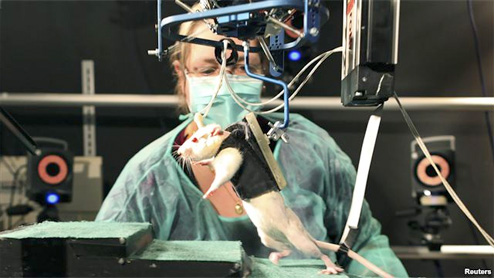
Millions of people around the world suffer from severe spinal cord injuries that result in permanent loss of control of their arms or legs, or loss of bladder, bowel or sexual functions.
Now, US researchers have developed an oral medication that offers hope that some of these lost functions could be regained. When given to laboratory mice shortly after a spinal cord injury, the drug restored the animals’ mobility.The experimental drug, called LM11A-31, works by blocking the release of a protein that after spinal cord injuries destroys oligodendrocytes, which are nerve cells that surround and protect axons. Axons are the long, thread-like nerve-cell projections that help transmit motor impulses between the brain and the rest of the body.
In experiments with mice with crippling spinal cord injuries similar to those seen in humans, the drug overcame a major hurdle in conventional therapies. The compound easily crossed the blood-brain barrier – the natural partition that protects the brain from potentially harmful foreign substances in the bloodstream – and prevented the normal post-injury die-off of oligodendrocytes.Sung Ok Yoon, a molecular biologist at Ohio State University Columbus, led the study. Four hours after the mice were injured, Yoon said, researchers began giving them three different doses of LM11A-31.
“We looked at their walking behavior. And the second thing we did [is a] non-weight-bearing test, which is a swimming test, because once you are injured it is hard for them to bear the weight of their body,” said Yoon. “So in [the swimming] test, they don’t have to. So maybe we can look at properties of motor control or motion that is not affected by the weight-bearing ability.”Treatment with the compound lasted 42 days. Yoon said animals receiving the highest dose of the drug could eventually walk and move their limbs in a coordinated fashion.
It takes up to a year for oligodendrocytes to die, said Yoon, who added that she hopes to conduct further experiments to see how effective LM11A-31 is if not given until weeks or months after an injury has occurred.Currently, the main treatment for reducing paralysis from spinal cord injury is an anti-inflammatory drug called methylprednisolone. It must be administered within eight hours but not more than 24 hours after an injury to be effective.Yoon said she also would like to conduct additional experiments to see whether LM11A-31 improves current treatments for spinal cord injury.
“So if this drug is beneficial, maybe it could be used in conjunction with current therapy and improve some function,” she said.Some crippling autoimmune diseases, including Guillain-Barre syndrome and multiple sclerosis, also involve the destruction of protective cells surrounding axons. Yoon believes it is possible LM11A-31 could be helpful in the treatment of those conditions, as well.Yoon and colleagues at the University of California in San Francisco published their work in The Journal of Neuroscience. – VOA












